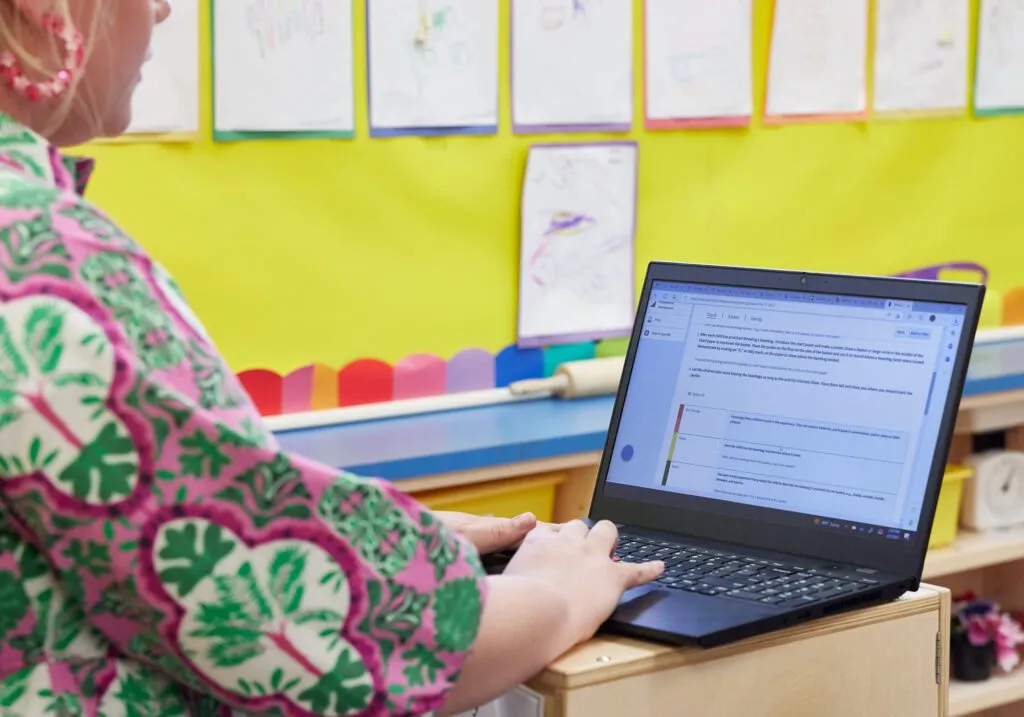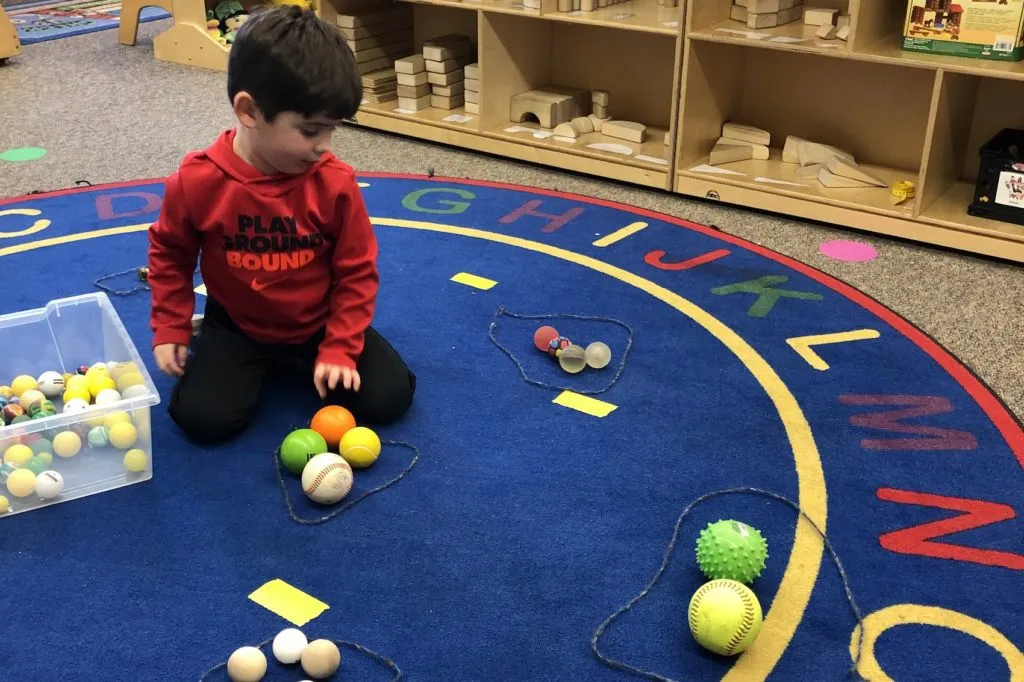Forward, Together in FWISD – A District and Community Focused on Its Early Learners
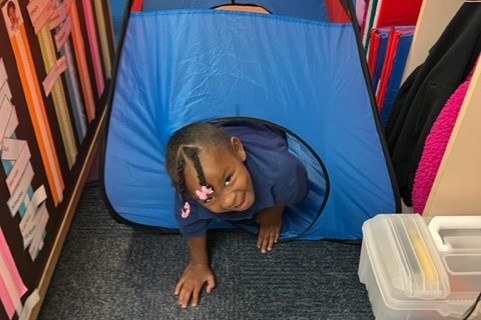
CHALLENGE: Establish an Early Learning Environment That Fosters Growth for Every Child
When school leaders in the Fort Worth Independent School District (FWISD) reflected on how to best support the diverse needs of its over 73,000 students and provide a pathway to success in school and in life, each department, including PreK–12, considered their role in making meaningful change together.
90% of brain development occurs before kindergarten, and it was an adoption year, so FWISD leadership examined their current PreK program and considered whether they wanted to continue using their current curriculum or adopt something new.
Because their existing curriculum was heavily scripted and provided little individualization, they decided to select a new curriculum. Additionally, the curriculum’s thematic units didn’t honor the children’s natural curiosity or value each child’s unique and individual differences, cultures, skills, and abilities. During the evaluation process, they carefully reviewed four early learning curriculums, looking for a solution that would address those shortcomings and provide a pathway to success for children.
SOLUTION: Select a Curriculum That Promotes Individualized Learning and Honors Children’s Natural Curiosity
Executive Director of Early Learning Olayinka Moore-Ojo and Dr. Marcey Sorensen, Chief Academic Officer, spearheaded the effort to select the new curriculum. Olayinka kicked things off by creating a review committee comprised of educators across FWISD. She included educators in the technology and equity departments and PreK–12 teachers with an array of content area expertise and surveyed all PreK teachers to get their input.
The committee developed a rubric to evaluate the PreK curricula. They wanted to find a research-based curriculum that focused on educating the whole child and provided
- differentiation for children demonstrating skills at, above, or below widely held expectations for PreK children;
- a culturally and linguistically responsive approach that valued the everyday lives of people in its diverse community, especially its multilingual learners and their families;
- seamless and ongoing family engagement with easy ways to communicate and share experiences from the classroom to home;
- implementation support for teachers throughout the adoption; and
- resources and technology tools that would be easy to use and save them time.
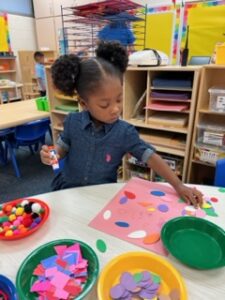 “Knowing that we ended up choosing a curriculum that marked a huge shift from what we’ve done in the past, it was very important to know that teachers had the opportunity to provide input on the process,” Olayinka said. “So, it wasn’t us giving them something. It was us taking what was important to them and together selecting what was best for the students.”
“Knowing that we ended up choosing a curriculum that marked a huge shift from what we’ve done in the past, it was very important to know that teachers had the opportunity to provide input on the process,” Olayinka said. “So, it wasn’t us giving them something. It was us taking what was important to them and together selecting what was best for the students.”
Clara Williams, a PreK teacher who has spent 30 years in FWISD, was among the teachers in support of The Creative Curriculum —the curriculum ultimately chosen by the district.
“I’ve been teaching PreK for a long time, so I’ve seen a lot of early learning curriculums,” she said. “And I have to honestly say that The Creative Curriculum is absolutely amazing. It takes me back to when I was little, and I had the chance to discover and play and learn. This program embraces the fact that play is central to learning.”
When teaching students, it’s not best practice for us to have characters or resources that are imaginary or fairytale-based or that encourage students to see themselves through animal representation. The Creative Curriculum uses everyday materials—such as boxes and water—and experiences that relate to the daily life of our students. For example, they get boxes delivered at home, they see a fire truck station and think about water, and they see people who look like them working in those fields.
Olayinka Moore-Ojo
Executive Director of Early Learning
FWISD, Texas
RESULTS: An Equitable, Individualized, Playful Learning Experience Ignites Learning
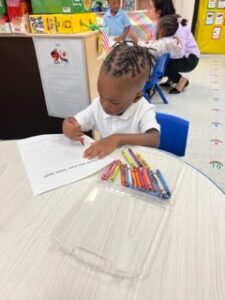 FWISD began their implementation of The Creative Curriculum in the 2021–2022 school year. Since then, the curriculum has prioritized the growth and learning of each child, strengthened family engagement, provided teachers with meaningful support, and deepened community ties.
FWISD began their implementation of The Creative Curriculum in the 2021–2022 school year. Since then, the curriculum has prioritized the growth and learning of each child, strengthened family engagement, provided teachers with meaningful support, and deepened community ties.
Early Impact on Math and Literacy
Teachers have already seen an impact on learning outcomes. In the 2021-2022 school year, 40 of 80 classrooms began using The Creative Curriculum. At the end of the first year, there was an increase in phonological awareness, and dual-language PreK teacher Liliana Lopez noted that 80% of the children in her class could count to 30, and 75% could recognize 20 or more letters and sounds. According to her, these changes were made possible because the curriculum allows teachers “to incorporate both math and literacy in ways that are engaging and beneficial for students.”
In the 2022-2023 school year, all 80 classrooms began using The Creative Curriculum. There have already been even more significant gains: at mid-year, the 2022-2023 classes have seen a 4-point increase in the percentage of children meeting the benchmark for “On Track” in phonological awareness, for both English and Spanish-speaking children, over the previous year’s classes.
Increasing Equity and Engagement for Children and Families
At the heart of The Creative Curriculum are children and their families, so it’s no surprise teachers have noticed a new level of engagement with both.
Clara is seeing something that she hasn’t before in her over 30 years of teaching at FWISD: a noticeable difference in the four-year-olds who started with The Creative Curriculum the year prior.
The play-based studies supported by the curriculum promote active, hands-on learning and inquiry, helping to diminish disruptive behaviors. “The children are helping create the atmosphere,” Clara said. “They’re so engaged with the different things we’re doing that I don’t have to redirect them a lot…I think it’s because they’re doing what they love to do—they love to play and learn.”
The new curriculum also drives family engagement more deeply, in a seamless, authentic way.
“A lot of my families have said that they love how [family engagement] is embedded in the curriculum,” said Kendall Ladner, a PreK-3 teacher at FWISD. “It’s super easy for them to connect and do things with their children at home.”
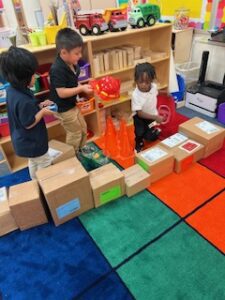 Seeking to advance equity and inclusion through a culturally and linguistically responsive approach, The Creative Curriculum also offers a wide range of resources to help multilingual teachers and learners succeed. This includes transadapted materials—from books to nursery rhymes—that retain their social and cultural significance. Liliana considers these multilingual resources invaluable, especially in a district where so many children speak a language other than English at home.
Seeking to advance equity and inclusion through a culturally and linguistically responsive approach, The Creative Curriculum also offers a wide range of resources to help multilingual teachers and learners succeed. This includes transadapted materials—from books to nursery rhymes—that retain their social and cultural significance. Liliana considers these multilingual resources invaluable, especially in a district where so many children speak a language other than English at home.
“With our former curriculum, I had to translate the teaching materials from English to Spanish, whereas now everything is translated for me,” Liliana said. “And the children’s activities, such as Mighty Minutes rhymes for example, aren’t just translated, they are transadapted, so both the English and Spanish versions are meaningful to children.”
Giving Teachers More Time Back
To best support educators and the children they teach, The Creative Curriculum doesn’t limit learning to classroom themes, and it doesn’t require teachers to chase down specific materials for those themes and to continuously recreate their classroom environment.
Instead, The Creative Curriculum allows teachers to set up their classroom one time in a thoughtful, intentional way, creating an engaging environment where the children’s work fills the walls—classrooms where children know the routines, where they learn by having fun, and where they feel at home.
For Kendall, this has made a big difference. According to her, the district’s former curriculum was particularly taxing for teachers due to its emphasis on classroom themes.
“We would stay at school super late when it was time to switch to our next unit,” she said. “Whereas with The Creative Curriculum, almost everything we need for each study is already in our classroom. And if we don’t have something, it’s very easy to find it. It’s not like I have to go out and buy a new set of toys or props.”
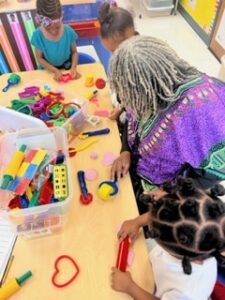 Teachers can also plan in a few simple clicks. These plans put everything teachers need for daily instruction right at their fingertips, giving them another invaluable resource: more time.
Teachers can also plan in a few simple clicks. These plans put everything teachers need for daily instruction right at their fingertips, giving them another invaluable resource: more time.
“I don’t have to spend my whole planning period doing a lesson plan or spend extra time outside of work doing it,” Liliana said. “Everything is already there, and it’s so easy to use.”
The Creative Curriculum doesn’t just prioritize teachers by making it easy to access the materials they need; it supports them with ongoing professional development.
Even Clara, a 30-year veteran of the early learning field, has taken advantage of the curriculum’s professional development.
“Teaching Strategies has on-demand videos that help me explore concepts that I might not understand and that cover the research behind the books they offer,” she said. “I’ve spent many a Saturday morning with Teaching Strategies, and I can do it at my leisure—drink my coffee, enjoy a video, and then reflect.”
Making an Impact With the Community
The effects of The Creative Curriculum have rippled across the Fort Worth community, helping bring people together in new ways.
Many teachers have noticed that both families and community members have been eager to contribute to the curriculum’s play-based, hands-on investigations, all of which use everyday items that resonate with children’s daily lives.
“It’s actually been quite easy” to find the materials needed for the investigations, Clara said. “I’ve gotten donations from families. But even community members who don’t have children have donated things they have at home. They’re not items they have to go out and buy—they’re just household things we can use.”
Liliana also noted how The Creative Curriculum provides the social–emotional support children need. Since PreK is often the first time a child is attending school and leaving their family, it can be scary to meet new adults they do not know.
“There was a question of the day that asked, ‘Who are some people who work at your school?’ So we talked about the principal, the nurses, and the PreK teachers while I showed them pictures of each one. That was so helpful. It’s not something all curriculums do.”
While it’s difficult to measure the myriad ways The Creative Curriculum has impacted teachers, children, and families across FWISD, perhaps Clara summed it up best: “I love The Creative Curriculum because it provides the resources teachers need to establish an environment where children can interact, grow, discover, and learn.”
